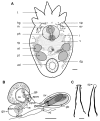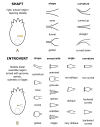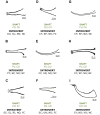A new flatworm species of Temnocephala (Rhabdocoela, Temnocephalidae) ectosymbiont on the freshwater crab Valdivia serrata (Decapoda, Trichodactylidae) from Amazonas, Colombia
- PMID: 32210662
- PMCID: PMC7082368
- DOI: 10.3897/zookeys.918.38201
A new flatworm species of Temnocephala (Rhabdocoela, Temnocephalidae) ectosymbiont on the freshwater crab Valdivia serrata (Decapoda, Trichodactylidae) from Amazonas, Colombia
Abstract
A new species of temnocephalan is described from the branchial chambers of Valdivia serrata in Colombia as Temnocephala ivandarioi sp. nov. The most distinctive characters of the new species are in the cirrus and the epidermal 'excretory' syncytial plates. In the present study, the terminology to describe the cirrus of species of Temnocephala is updated. Comparison between the shape of the cirrus of the temnocephalans associated with trichodactylid crabs is also provided.
Keywords: Crustacea; Reserva Natural Tanimboca; Temnocephala ivandarioi sp. nov.; taxonomy.
Carolina Lenis, Freddy Ruiz, Carlos Muskus, Antonio Marcilla, Imelda Vélez.
Figures






References
-
- Amato JFR, Amato SB, Seixas SA. (2005) Temnocephala lutzi Monticelli (Platyhelminthes, Temnocephalida) ectosymbiont on two species of Trichodactylus Latreille (Crustacea, Decapoda, Trichodactylidae) from southern Brazil. Revista Brasileira de Zoologia 22: 1085–1094. 10.1590/S0101-81752005000400038 - DOI
-
- Amato JFR, Amato SB, Seixas SA. (2006) A new species of Temnocephala Blanchard (Platyhelminthes, Temnocephalida) ectosymbiont on Trichodactylus fluviatilis Latreille (Crustacea, Decapoda, Trichodactylidae) from southern Brazil. Revista Brasileira de Zoologia 23: 796–806. 10.1590/S0101-81752006000300026 - DOI
-
- Amato JFR, Amato SB, Seixas SA, Fonseca M, Ilário RJ. (2010) Temnocephala pignalberiae Dioni, 1967 (Platyhelminthes, Temnocephalida) from two allopatric populations of Dilocarcinus pagei Stimpson, 1861 (Crustacea, Decapoda) – first record for Brazil. Zootaxa 28: 15–28. 10.11646/zootaxa.2613.1.2 - DOI
-
- Arias-Pineda JY, Damborenea C, Castro AJJ. (2015) A new species of Temnocephala (Platyhelminthes, Temnocephalida) in mountain crabs from Tolima, Colombia. Neotropical Helminthology 9: 253–263. http://sisbib.unmsm.edu.pe/BVRevistas/neohel/v9n2/pdf/a05v9n2.pdf
-
- Baer JG. (1953) Zoological results of the Dutch New Guinea Expedition 1939: No. 4. Temnocephales. Zoologische Mededelingen 32: 119–140. https://www.narcis.nl/publication/RecordID/oai:naturalis.nl:318015
LinkOut - more resources
Full Text Sources
